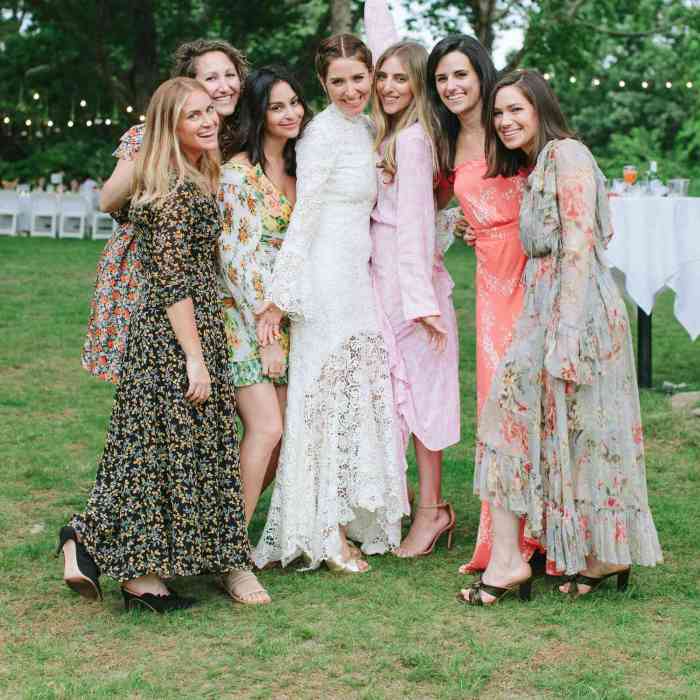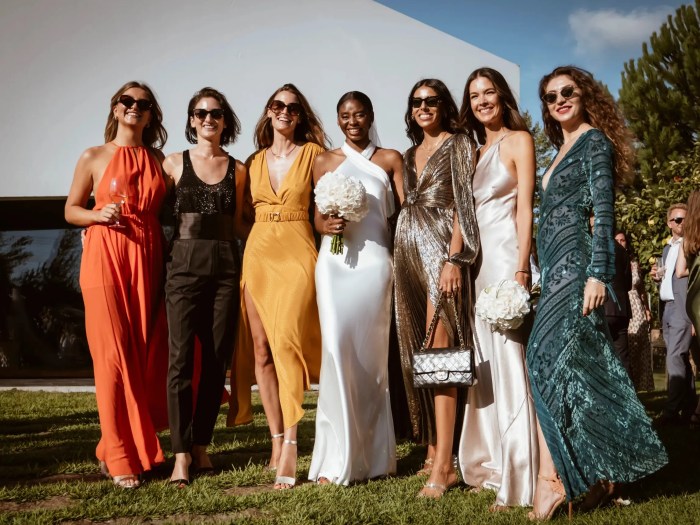Boutique Wedding Dresses: A Guide to Exquisite Bridal Style: Boutique Dresses For Wedding
Boutique dresses for wedding – Choosing a wedding dress is a momentous occasion, and selecting a gown from a boutique offers a unique experience beyond mass-produced options. This guide delves into the world of boutique wedding dresses, exploring their defining characteristics, design elements, shopping experience, styling options, and the marketing strategies employed by boutique shops.
Defining “Boutique Dresses for Wedding”

Source: brides.com
Boutique wedding dresses stand apart from mass-market options through superior quality, unique designs, and a personalized shopping experience. Unlike larger retailers offering standardized styles, boutiques focus on exclusivity and craftsmanship. They often feature intricate detailing, luxurious fabrics, and bespoke tailoring options unavailable in mainstream stores.
Styles and silhouettes vary widely, encompassing classic ball gowns, sleek sheath dresses, romantic A-lines, and modern separates. Price ranges typically start from several thousand dollars and extend upwards depending on fabric, embellishments, and designer reputation. The target customer is typically a bride seeking a high-end, personalized experience and willing to invest in a unique, high-quality garment.
Fabric and Design Elements
High-end wedding dresses utilize a range of luxurious fabrics, each contributing to the dress’s drape, texture, and overall aesthetic. Silk, particularly charmeuse and crepe, offers a luxurious sheen and drape, ideal for flowing silhouettes. Lace, whether delicate Chantilly or heavier Alençon, adds intricate detailing and romantic appeal. Tulle provides volume and texture for full skirts, while organza creates a crisp, structured look.
These fabrics’ suitability varies depending on the season and desired aesthetic; silk is versatile, while heavier fabrics might be better suited for cooler months.
Embellishments such as lace, beading, and embroidery significantly impact both the aesthetic and price point. Intricate beadwork and hand-sewn embroidery add a level of artistry and increase the overall cost. The choice of embellishments should complement the dress’s silhouette and the bride’s personal style.
Design Concepts:
- Design 1: A classic A-line gown in ivory silk crepe, accented with delicate Chantilly lace appliqués along the bodice and skirt. Target audience: Classic, elegant bride; suitable for a traditional church wedding.
- Design 2: A modern sheath dress in blush pink silk charmeuse, featuring intricate beading along the neckline and waist. Target audience: Modern, sophisticated bride; suitable for a city hall or modern venue wedding.
- Design 3: A bohemian-inspired gown in flowing tulle, adorned with floral embroidery and delicate beading. Target audience: Romantic, free-spirited bride; suitable for a garden or beach wedding.
Shopping Experience and Customization, Boutique dresses for wedding
The shopping experience at a boutique differs significantly from that at a larger retailer. Boutiques offer a more personalized and intimate experience, with dedicated stylists providing expert advice and guidance. Appointments are typically scheduled, allowing for undivided attention and a more relaxed atmosphere. Larger retailers often have a more crowded and less personalized experience.
Customization options are a key differentiator. Boutiques frequently offer alterations, bespoke designs (creating a dress from scratch), and unique accessories tailored to the bride’s vision. This level of personalization ensures the dress perfectly complements the bride’s body type, style, and wedding theme.
Step-by-Step Guide for Boutique Wedding Dress Shopping:
| Step | Action | Details | Timeline |
|---|---|---|---|
| 1 | Schedule an Appointment | Contact boutiques, inquire about availability, and book an appointment well in advance. | 6-12 months before wedding |
| 2 | Initial Consultation | Discuss style preferences, budget, and wedding details with a stylist. | During appointment |
| 3 | Dress Selection | Try on dresses, considering silhouette, fabric, and embellishments. | During appointment |
| 4 | Fitting and Alterations | Schedule fittings for adjustments and final alterations. | Several weeks before wedding |
Styling and Accessories
Styling a boutique wedding dress involves considering the bride’s body type, venue style, and wedding theme. A simple sheath dress might be styled with bold jewelry for a modern look, while a romantic ball gown could be paired with delicate accessories for a classic feel. The venue also plays a role; a beach wedding might call for a more relaxed style, while a formal ballroom setting demands elegance.
Complementary Accessories:
- Veils (cathedral, birdcage, blusher)
- Jewelry (earrings, necklaces, bracelets)
- Shoes (heels, flats, sandals)
- Headpieces (floral crowns, tiaras)
- Gloves
Hairstyle and Makeup Examples:
A classic updo with soft curls complements a traditional ball gown, creating an elegant and timeless look. A natural, dewy makeup look with soft pink tones enhances the overall romantic feel. For a modern sheath dress, a sleek low bun or loose waves with a bold lip create a chic and sophisticated vibe. A smoky eye and contoured makeup add drama and glamour to a more dramatic gown.
A loose braid and fresh, minimal makeup is perfect for a bohemian style wedding dress.
Marketing and Branding

Source: vogue.com
Marketing Copy Example: “Experience the artistry of bespoke bridal design at [Boutique Name]. We create unforgettable wedding dresses tailored to your unique vision, using the finest fabrics and meticulous craftsmanship. Schedule your consultation today and let us help you find your dream gown.”
Branding Visual Representation: Imagine a sophisticated brand identity with a muted color palette of blush pink, ivory, and champagne gold. The logo would feature an elegant script font, possibly incorporating a delicate floral element. The overall aesthetic would be refined, luxurious, and timeless, reflecting the high-end nature of the boutique.
Marketing Strategy Comparison: One boutique might focus on social media marketing, showcasing stunning imagery and behind-the-scenes glimpses of the design process to appeal to a younger, visually-driven audience. Another might emphasize personalized service and client testimonials, targeting a more discerning clientele seeking a high-touch experience.
FAQ Resource
How far in advance should I start shopping for a boutique wedding dress?
Finding the perfect boutique dress for a wedding can be a delightful experience. Many options exist, from classic silhouettes to modern designs. However, if you’re considering a more understated yet elegant choice, a sophisticated option might be a black maxi dress wedding guest outfit. Ultimately, the best boutique dress will depend on your personal style and the wedding’s formality, ensuring you feel confident and stylish.
Ideally, begin searching 9-12 months before your wedding to allow ample time for design, alterations, and potential delays.
What is the average cost of a boutique wedding dress?
Prices vary widely depending on designer, fabric, and embellishments, but generally range from $1,500 to $10,000 or more.
Can I bring guests to my boutique wedding dress appointment?
Most boutiques have a limited guest policy to maintain a focused and personalized experience. Check with the boutique beforehand.
What should I wear to my appointment?
Wear comfortable undergarments similar to what you plan to wear under your wedding dress for accurate fitting.
What if I need alterations after purchasing my dress?
Most boutiques offer alteration services, but it’s crucial to discuss timelines and costs upfront.
